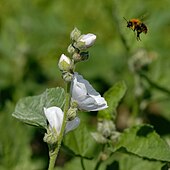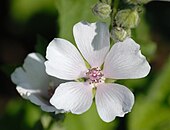Real marshmallow
| Real marshmallow | ||||||||||||
|---|---|---|---|---|---|---|---|---|---|---|---|---|

Common marshmallow ( Althaea officinalis ) |
||||||||||||
| Systematics | ||||||||||||
|
||||||||||||
| Scientific name | ||||||||||||
| Althaea officinalis | ||||||||||||
| L. |
The common marshmallow ( Althaea officinalis ), also called medicinal marshmallow , belongs to the mallow family (Malvaceae).
Naming
The botanical name Althaea (from Greek ἀλϑαία, "the healing") is derived from the Greek word ἄλθειν álthein , which means something like "to heal". The German plant name Eibisch can be traced back to Latin (h) ibiscum via Middle High German ībesch (also ĩbeschenwurz ) . Popularly there are also names as for the plant Althee , Age Thee , velvetleaf , Ibischwurz , Heilwurz , white mallow , Marsh mallow , Adewurz or mucus root .
More are in part only regional common names for the genuine marshmallow or were: Arteawurzel ( Rendsburg pharmacy), Ebich , Ebiche ( Middle High German ), old Eh ( Austria ), Eibesch , Eibich (Austria), Eibischwurz , Eibschen ( Zurich ), verbena , Grozpapel ( Old High German ), Heemst ( Netherlands ), Hemisch , Hemst (Netherlands), Homes , Hülfwurz , witte Hümst , Hünst ( Middle Low German ), Hüffwurzel ( Silesia ), Ibisch , Ibischa , Ibischpappel , Ibsche ( Bern , Middle High German), Ibschge ( Zurich), Ipsch (Middle High German), witte Malve , Pallenblöm (related to the blossom), white or wild poplar , wilt Pippeln , velvet poplars , Rockwort (Middle Low German), tea root (Rendsburg pharmacy), Ungerschkrud , wheat poplar , Ybesce , Ybesch , Ybesche , Ybischa , Ybischea , Ybize and Ywesche (Middle High German).
description
The common marshmallow is an upright, herbaceous plant of several years with strong shoot axes (stems). It reaches a size of 60 to 150 cm and blooms brilliantly white from July to August. Althaea officinalis is a valuable bee forage plant. In the subfamily Malvoideae, the many stamens have grown together to form a tube surrounding the pistil , the so-called Columna .
The number of chromosomes is 2n = 42.
Occurrence
The common marshmallow occurs wild in the steppe zones of southern Russia and Kazakhstan east to the Altai . In the west, the distribution in southern Europe extends from the Balkans via Italy to the Iberian Peninsula. The plant was brought to Central Europe by humans ( archaeophyte ), permanent overgrown occurrences are limited to coastal areas and inland salt areas. The plant appears temporarily in ruderal places, in gardens or on rubble sites . Sunny, warm locations with nutrient-rich, well-watered loam or clay soils are preferred. In Central Europe it is a character species of the Soncho-Angelicetum archangelicae, but also occurs in other societies of the order Convolvuletalia or the orders Molinietalia or Agrostietalia.
In Austria there is an autochthonous occurrence in Zwingendorf (Lower Austria).
Diseases
The common marshmallow is infested with uredia from the mallow rust.
use
Culinary use
For substances of the marshmallow plant originally confectionery was marshmallow that is now associated mainly with the United States, but to the established French de pâte guimauve or the so-called Eibischteig back. The name marshmallow is derived from the English-language name marsh mallow (German: marsh mallow ) for the marshmallow. The shoot axes (stems) and leaves as well as the roots were used for this ; today the industry uses substitutes for this .
In the past, people also ate the roots, which were first boiled and then fried. The flowers are also edible and the young leaves can be eaten in a salad. The Romans used the plant as a soup herb and for filling suckling pigs .
The white carrot-like root was used as food in times of famine. The only reference in the Bible alludes to the bland taste of marshmallow slime ( Hi 6,6 EU ): "Is fades eaten without salt, or is there taste in marshmallow slime?" This indicates that you should never get marshmallow slime without spice or at times of prosperity would have eaten.
Medical use
As a drug are used:
- The flowers (Althaeae flos) collected and dried during the flowering period from July to August.
- The leaves (Althaeae folium) collected and dried before and during flowering.
- The dried marshmallow root (Althaeae radix).
The mucous substances have an enveloping, irritation-reducing and soothing effect; Animal experiments have also shown anti-inflammatory and immune-stabilizing effects.
Already in antiquity, marshmallow was considered to be beneficial for podagra , hardening and swelling, intestinal pain and groin ulcers . Medieval phytotherapy also used the ( humoral pathologically hot and dry), "softening" effect Ebischwurzel (formerly also for the production of a marshmallow ointment, unguentum dialtheia , used) against "hard ulcers" or "tumors", " fractures ", " bumps " and apostems ”.
In traditional Persian medicine , for example, marshmallow is used to treat seborrheic eczema .
According to David Hoffmann's guide to herbs and medicinal plants, the root can be used for digestive disorders , inflammation in the digestive tract and skin , and the leaves for the lungs and urinary tract . Real marshmallow is recommended for bronchitis , colds and coughs and is soothing for urethritis ( urethritis ) and urine gravel and can be used externally for varicose veins and boils .
The European Medicines Agency (EMA) Committee for Herbal Medicinal Products (HMPC ) has published a monograph on marshmallow root. It confirms the traditional indications for various preparations, for example as an irritant-relieving drug for inflammation of the mouth and throat, to reduce coughing and for mild inflammation in the gastrointestinal area.
ingredients
Ingredients of the common marshmallow are mucilage (up to 25% in the roots), especially with galacturonorhamnans and arabinogalactans; Pectins and also starch in the roots.
literature
- Werner Ratfisch: On the history of the medicinal use of the marshmallow (Althaea officinalis L.). Medical dissertation, Leipzig 1936.
- Oskar Sebald (Ed.): The fern and flowering plants of Baden-Württemberg. Ulmer, Stuttgart 1990–1998 (8 volumes).
- Wolfgang Adler, Karl Oswald, Raimund Fischer: Excursion flora of Austria. Ed .: Manfred A. Fischer . Ulmer, Stuttgart / Vienna 1994, ISBN 3-8001-3461-6 .
- Karl Hiller, Matthias F. Melzig: Lexicon of medicinal plants and drugs. Area, Erftstadt 2006, ISBN 3-89996-682-1 .
- Ingrid and Peter Schönfelder : The new manual of medicinal plants , Franckh-Kosmos Verlagsgesellschaft, 2004, ISBN 3-440-09387-5
- K.Hiller / MFMelzig: Lexicon of medicinal plants and drugs . 2nd Edition. 2010, Spektrum Akademischer Verlag, ISBN 978-3-8274-2053-4
Web links
- Real marshmallow. In: FloraWeb.de.
- Distribution map for Germany. In: Floraweb .
- Althaea officinalis L. In: Info Flora , the national data and information center for Swiss flora . Retrieved December 8, 2015.
- Distribution in the northern hemisphere according to Eric Hultén
- Thomas Meyer: Data sheet with identification key and photos at Flora-de: Flora von Deutschland (old name of the website: Flowers in Swabia )
- Literature on Althaea officinalis in the Kew Bibliographic Databases (English)
- Hermann Adolf Köhler: Köhler's medicinal plants in lifelike illustrations with brief explanatory texts. Book scan at Biolib.de
Individual evidence
- ↑ Carl Jessen : The German folk names of plants. Publisher by Philipp Cohen, Hannover 1882, p. 23.
- ↑ a b Erich Oberdorfer : Plant-sociological excursion flora for Germany and neighboring areas . 8th edition. Verlag Eugen Ulmer, Stuttgart 2001, ISBN 3-8001-3131-5 . Page 657.
- ↑ G. Wolfram et al. 2006
- ↑ Peter Zwetko: The rust mushrooms Austria. Supplement and host-parasite directory to the 2nd edition of the Catalogus Florae Austriae, III. Part, Book 1, Uredinales. (PDF; 1.8 MB).
- ↑ a b David Hoffmann : Naturally healthy - herbal medicine . Over 200 herbs and medicinal plants and their effects on health. Ed .: Element Books . 1st edition. Element Books, Shaftesbury , England , UK 1996, Part Three: The Plant Directory, pp. 59 (256 pp., English: The Complete Illustrated Holistic Herbal . Shaftesbury, England 1996. Translated by Mosaik Verlag).
- ↑ Hans Zotter : Ancient medicine. The collective medical manuscript Cod. Vindobonensis 93 in Latin and German. Academic printing and Verlagsanstalt, Graz 1980 (= Interpretationes ad codices. Volume 2); 2nd, improved edition, ibid. 1986, ISBN 3-201-01310-2 , pp. 108-111.
- ↑ Dieter Lehmann: Two medical prescription books of the 15th century from the Upper Rhine. Part I: Text and Glossary. Horst Wellm, Pattensen / Han. 1985, now at Königshausen & Neumann, Würzburg (= Würzburg medical-historical research , 34), ISBN 3-921456-63-0 , p. 167 f.
- ↑ See also Jürgen Martin: Die 'Ulmer Wundarznei'. Introduction - Text - Glossary on a monument to German specialist prose from the 15th century. Königshausen & Neumann, Würzburg 1991 (= Würzburg medical historical research. Volume 52), ISBN 3-88479-801-4 (also medical dissertation Würzburg 1990), p. 124 ( dialtheia , dialtea ; “ditz pflaster hayst dyaltei”).
- ↑ Barbara Fehringer: The "Speyer herb book" with the medicinal plants of Hildegard von Bingen. A study on the Middle High German “Physica” reception with a critical edition of the text. Würzburg 1994 (= Würzburg medical historical research. Supplement 2), p. 61 f.
- ↑ Petrus Uffenbach (Ed.): Pedacii Dioscoridis Anazarbaei Kraeuterbuch… (translated into German by Johannes Danzius), Frankfurt am Main (with Johann Bringern) 1610, p. 238 f.
- ↑ Successful Treatment of Chronic Scalp Seborrheic Dermatitis Using Traditional Persian Medicine: A Case Report and Literature Review, Galen Medical Journal, 2018 Vol 7
- ↑ European Union herbal monograph on Althaea officinalis L., radix







